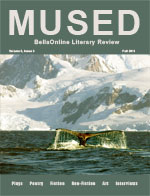Daughter of Story
Vivian Faith Prescott
Her first day on the job she sits in the van´s driver’s seat, turns to the ten people on her tour and begins to speak in her Lingít language. She is introducing herself according to custom, taught to her by her elders. She says, “Ch’a aadéi yei xat naay.oo. Please forgive me if I offend anyone and don’t say this correctly. Lingít X’éináx, Yéilk’ yoo xat duwasáakw. Dleit kaa X’éináx yoo xat duwasáakw..."
A man interrupts her from the back of the van. He yells, “Speak English! We can’t understand you.”
“Yéilk´ naax xat sitee. T’akdeintaan áyá xat.” She continues, “Tax’ hit aya xat. Teilkweidí yádi áyá xat. Hawaiian ka Norwegian yadí áyá xat. Kaagwaantaan dachxán áyá xat. Sáami ka Irish ka Suomalaiset áyá xat. David Mork yoo duwasáakw ax éesh. Yéilk´ tláa yoo duwasáakw ax tláa. Kachxana.aakw kuxdzitee ku.aa Xunaa kaawu dax. Sheet’ka Kwáan yei yatee. Gunalchéesh."
She sighs, thinks for a moment about swearing at them and getting off the bus and leaving them stranded. But she knows this might be the only exposure the visitors ever have to the Tlingit culture. She is it. She is her ancestors, Haa Sh’uka: Those who have died, those in the present, and those who will live on after her.
She politely recites to the tourists her English translation and explains the reason she spoke in Lingít was to give respect to her ancestors, elders, and visitors. She gives her Tlingit name including her moiety (Raven), in addition to her clan and house name, the T’akdeintaan from the Snail House (Tax’). She explains how she is child of the Teilkweidí, the Brown Bear. Her yadí (father’s people) are also Hawaiian and Norwegian. She is a grandchild of the Kaagwaantaan. She also acknowledges her Sáami, Suomalainen, Norwegian, and Irish heritage. She gives her father’s and her mother’s names and mentions she was born in Wrangell, Alaska (Kachxaana.aakw) and her kwáan comes from Hoonah, and now she lives in Sitka.
She drives the tourists around town, pointing out the bald-eagle and teaches them to say Ch’áak’. She points at Mt. Edgecumbe, L’ux, and shows them the sea lions—taan. She has them taste her world: the salmonberry, spruce tips and blueberries. She has them listen to her world: eagles screeching, ravens cawing. She tells them if they listen closely, Raven is teaching them Lingít letters. Everything is story. She explains how her people are in the middle of language revitalization. She has the tourists smell the seaweed, feel the texture of her world. At the end of the tour, the man who told her to shut up and speak English gives her the biggest tip of the day and thanks her for the tour. This was the first day of many attempts to bridge the gap between the known and the unknown, between the listener and the storyteller.
On another tour day, she explains to a group that her ancestors have been in Southeast Alaska for ten-thousand years. For some reason, they can´t wrap their brains around that much time, so they argue with her. How can people live in one place for so long? To answer this she refers to the Glacier Bay story, the Volcano story, the Salmon Boy story, and they laugh, not understanding that the stories are proof that a rich culture has existed for a long time—Salmon Boy, Bear’s tracks in Lituya Bay, the rocks on the Alsek River are proof enough. She is proof enough. So she opens her mouth and begins, "We came down the river under the ice..."

